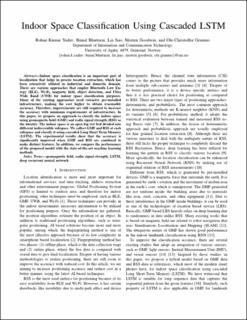Indoor Space Classification Using Cascaded LSTM
Journal article, Peer reviewed
Accepted version

Åpne
Permanent lenke
https://hdl.handle.net/11250/2735071Utgivelsesdato
2020Metadata
Vis full innførselSamlinger
Originalversjon
Yadav, R. K., Bhattarai, B., Lei, J., Goodwin, M. & Granmo, Ole-C. (2020). Indoor Space Classification Using Cascaded LSTM. IEEE Conference on Industrial Electronics and Applications, 1110-1114. https://doi.org/10.1109/ICIEA48937.2020.9248347Sammendrag
Indoor space classification is an important part of localization that helps in precise location extraction, which has been extensively utilized in industrial and domestic domain. There are various approaches that employ Bluetooth Low Energy (BLE), Wi-Fi, magnetic field, object detection, and Ultra Wide Band (UWB) for indoor space classification purposes. Many of the existing approaches need extensive pre-installed infrastructure, making the cost higher to obtain reasonable accuracy. Therefore, improvements are still required to increase the accuracy with minimum requirements of infrastructure. In this paper, we propose an approach to classify the indoor space using geomagnetic field (GMF) and radio signal strength (RSS) as the identity. The indoor space is an open big test bed divided into different indiscernible subspace. We collect GMF and RSS at each subspace and classify it using cascaded Long Short Term Memory (LSTM). The experimental results show that the accuracy is significantly improved when GMF and RSS are combined to make distinct features. In addition, we compare the performance of the proposed model with the state-of-the-art machine learning methods.